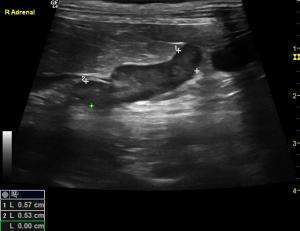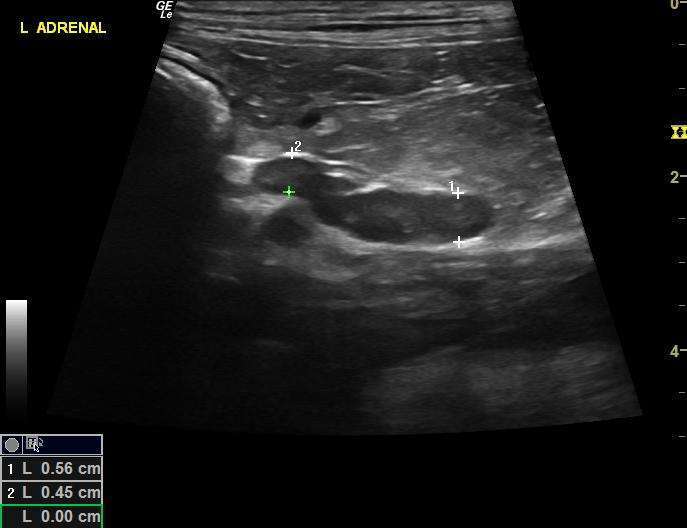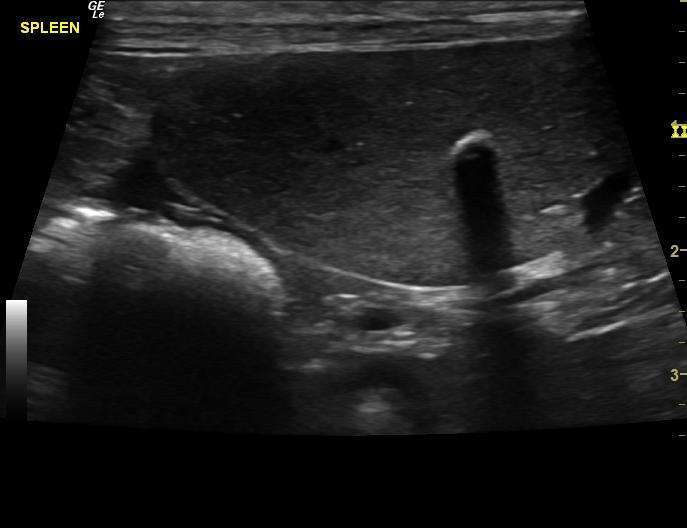– I have inherited this nightmare case as a second opinion and just wanted to pick some brains on this
– Harriette is a 7 yr old FS Boston Terrier with too many problems to list but a distinct history of PU/PD
– moderate elevation in ALP, mild elevation in ALT
– LDDST negative for Cushings and ultrasound performed elsewhere and read by a radiologist stated normal adrenal glands, normal iver, some inciental mineral in the spleen – all else normal.
– I have inherited this nightmare case as a second opinion and just wanted to pick some brains on this
– Harriette is a 7 yr old FS Boston Terrier with too many problems to list but a distinct history of PU/PD
– moderate elevation in ALP, mild elevation in ALT
– LDDST negative for Cushings and ultrasound performed elsewhere and read by a radiologist stated normal adrenal glands, normal iver, some inciental mineral in the spleen – all else normal.
– this patient looks like she has Cushings inappearance and has small subtle plaques on her skin that are suspisious for calcinosis cutis which I will likely get a chance to biopsy
– I repeated the ultrasound and to me the liver is diffusely hyperehoic (steroid hepatopathy?); the adrenals are normal in size for the patient but appear “plump”, heterogensous and with regions of dystrophic mineralization; the lesions in the spleen I have seen with patients with Cushings in the past
– I am running an ACTH stimulation test
So any thought on these sonographic lesions?



Comments
The adrenal fit within normal
The adrenal fit within normal limites but that can be th ecase in about 10-15% of pdh cases. Dystrophic renal mineralization. This is the algorythm we use:
Efficient & Accurate Cushings Work up-Lindquist
Notes regarding Cushing’s Clinical Presentations:
Nearly all Cushings dogs have SAP elevations and true PU/PD (USG < 1.025) and most are polyphagic.
Cushings dogs are > 6 years and usually > 9 years old, usually have poor skin coats, body scores > 3/5, and are
usually sedentary animals.
Its important to remember that Cushings dogs usually look and play the part and other diseases cause false + stress
related cortisol spikes. On rare occasion a Cushings dog will not follow the rules but this is truly an exception.
Potential Cushings patient workups can be costly and frustrating if not definitive and, in my experience, the non
definitive patient usually has something else going on that may be contributing to some of the clinical signs a cushings
dog will have, especially SAP elevations or PU/PD. Based on this prelude of information I came up with the following
algorithm in the spirit of diagnostic efficiency.
The following suggested protocol is based on current available literature on Cushings disease and extensive clinicalsonographic
experience evaluation + Cushings and False + LDDST & ACTH stim. cases in order to maximize the
efficiency of a Cushing’s workup in practice.
Screen first, workup second
1) UA: Repeatable (2-3 urine samples) Urine specific gravity & urine cortisol/creatinine ratio (UCCR): If repeatable
USG< 10.20 and + UCCR move to next step 2.
Note: UA is inexpensive and easy to obtain and if UA criteria is not met for Cushings then resources can be spent into
other more pertinent diagnostics or left on hold until the UA criteria is met in emerging Cushings cases.
2) Sonogram: Does the patient have concurrent disease clinically or sonographically as non-Cushings illness will
influence the potential false + LDDST or even ACTH stim. The sonogram gives a global perspective of the internal
health of the patient to be considered in the Cushings workup as an assessment of concurrent disease. Is there a
concurrent neoplastic process, UTI pancreatitis, mucocele….? Are the adrenals enlarged (Cushings-PDH, stress, age
related or breed variant), or atrophied (Iatrogenic Cushings or adrenal burnout), have asymmetric enlargement
( Adrenal tumor, hyperplasia, adenoma, age related variant), or is there vascular invasion (Invasive pheo with false +
UA criteria or adenocarcinoma or phrenic thrombosis)? The sonogram answers these questions proactively.
3) LDDST (0.01 D-Sodium phosphate mg/kg IV) (Better screening test but plagued with false +) Use if there is potential
early Cushings or if adrenal asymmetry present on sonogram suspecting tumor. Use LDDST in cats at a higher dose
(0.1 mg/kg IV).
OR
4) ACTH stim. (Better confirming test but can have false +) Use if the patient “looks” Cushingoid or if bilateral adrenal
enlargement is present, or high normal width on sonogram, or if iatrogenic Cushings suspected (Cortisone tx in past).
5) If diabetic then run both LDDST & ACTH stim.
5) Run a serial blood pressure in a BP friendly non “white coat effect” atmosphere. Run at least 3 at different times
over a few hours or when eating as the patient tends to be calm when eating or give Torbutrol when entering the facility.
6) Perform CT of the pituitary to identify macroadenoma expansion if any lethargy or dullness or other central clinical
CNS signs are minimally present.
Suggested reading:
Behrend EN, Kooistra HS, Nelson R, et al. Diagnosis of Spontaneous Canine Hyperadrenocorticism: 2012 ACVIM
Consensus Statement (Small Animal). J Vet Intern Med 2013;27:1292–1304 .
Thank-you EL – frustrating
Thank-you EL – frustrating disease at times.
Yes i agree I still think we
Yes i agree I still think we dont know enough about this disease and adrennal structural behavior here.
I agree and I have seen many
I agree and I have seen many cases now where adrenal “size“ was considered normal so that 10-15 % may be underestimated.
Update: ACTH strongly
Update: ACTH strongly positive for hyperadrenocortism
Urine SG fluctuates between 1.015 – 1.048 so imporatant to check more than one!
Starting trilostane
Skin biopsies pending
Yeh there is that emerging
Yeh there is that emerging pdh phase that is tough to put the finger on… excellent point on the serial USG and I would say th eserial BP as well because 50% of cushingoid patients are hypertensive as i recall from a study.
Remo any input here?
Cushing’s can sometimes throw
Cushing’s can sometimes throw a curve ball: typical clinical signs but normal urine SG, ALP activity and no adrenomegaly and occasionally a normal ACTH stim, which then requires a low-dose dexamethasone suppression test to confirm.Hypertension is around 60-86% with a higher prevalence seen with unilateral adrenal tumors.